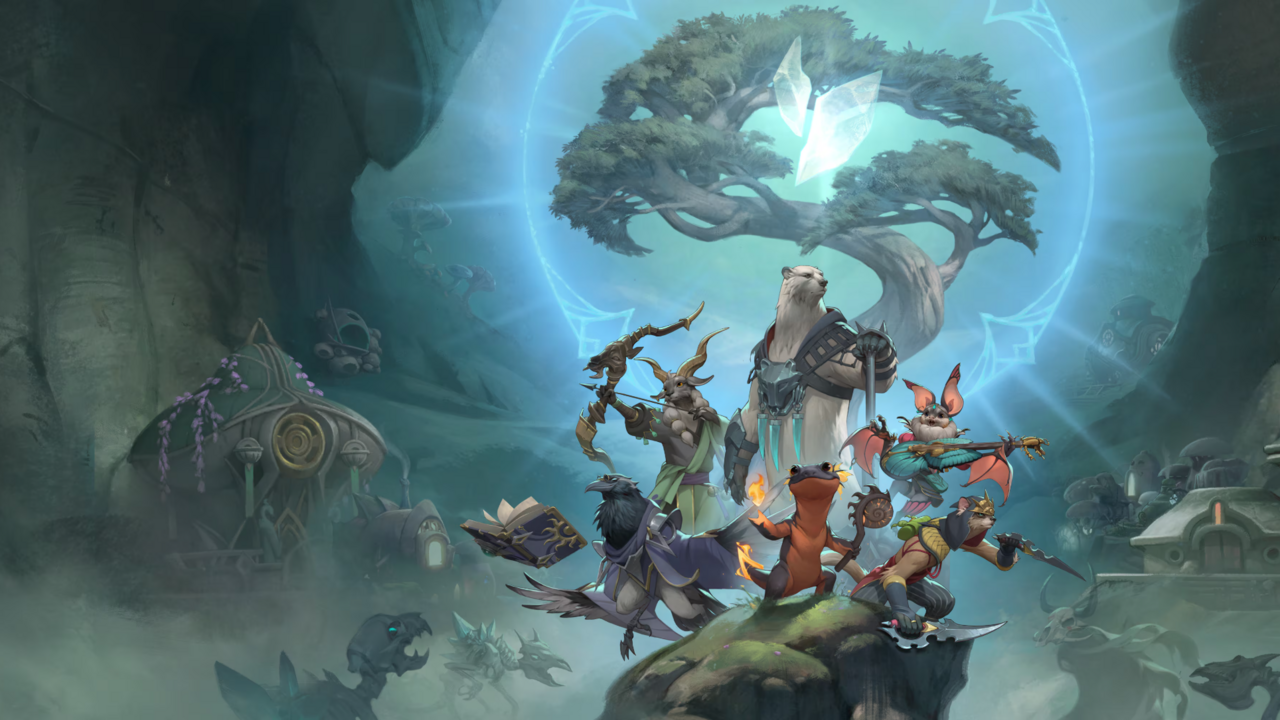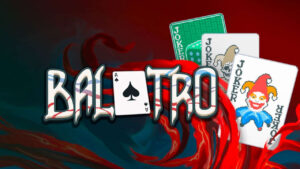Sunderfolk feels at its best when you’re playing together with friends on the couch during what would have otherwise been an uneventful weekend afternoon. The game embodies two of my favorite aspects of tabletop RPGs: strategic teamwork and memorable anecdotes. It does struggle to be fun when you’re playing solo, but that feels like it’s clearly the wrong way to play the tabletop-inspired, turn-based tactical RPG, which really only comes together when different minds are working together to coordinate their respective perks and customized deck of card-based abilities to strategically accomplish the task at hand.
In Sunderfolk, each player takes control of one of six anthropomorphic heroes: an arcanist crow, a pyromancer axolotl, a ranger goat, a bard bat, a berserker polar bear, or a rogue weasel. After proving themselves capable bouncers in a tavern, the heroes band together to protect their home village, Arden, from a series of escalating threats and try to find a way to prevent the growing corruption of the magical tree that keeps everyone safe from the coming darkness. It’s your typical run-of-the-mill fantasy setup, with would-be heroes rising to heed the call of adventure when no one else will, and for the first few hours, Sunderfolk doesn’t do much to differentiate itself from contemporary stories.
But then you get to really know the NPCs, and Sunderfolk’s story starts to make its mark with its varied cast of characters, all of whom are voiced by actor Anjali Bhimani to replicate the experience of playing a tabletop adventure with a Game Master who is portraying all the non-hero characters. Bhimani does an incredible job adjusting the pitch, tone, accent, and speed of her voice to add a distinct flavor to every character, injecting a feeling of life into the narrative that makes it easy to love the heroes’ allies and effortless to hate the villains. My friends and I were far more invested in saving the village and discovering what was going on upon meeting an adorable, one-armed penguin orphan named Amaia who was doing her best to keep Arden’s mines running, especially once her cruel and lying uncle was introduced. We vowed to do everything to save the little bird (and desperately hoped her uncle would be revealed as the true big bad so that we’d have a chance to destroy him), and much of that emotional investment, as well as our feelings about the other characters, was derived from Bhimani’s portrayal.
Playable on both console and PC, Sunderfolk is controlled via a free app downloaded to players’ phones or tablets–the game plays out on your computer monitor or TV, but you look down at your phone to peruse your available options. The crux of the gameplay sees the heroes take on missions, most of which boil down to killing every foe on the board–there are usually additional objectives thrown in like defending a point, chasing down an ally and keeping them from being captured, or exploring a space, but every assignment comes back to fighting. Each of the heroes has their own unique collection of abilities, displayed as cards on each person’s phone or tablet. On each turn of a mission, each player can play one of their cards, mapping their movements and selecting the target of their attacks using the touchscreen on their mobile devices. On the easiest difficulty, it’s possible to get by doing whatever you want, but on every other difficulty, you’re encouraged to talk through your available moves with your allies to plan the best possible combination of cards and overcome the enemies’ typically larger numbers. Once someone starts taking their turn, it stops the other players from going but you can easily exit out in the midst of mapping things out if everyone decides it’s better for someone else to go first, and the party can go in whatever order they want. You’re only locked in once you’ve started moving or attacking, and as far as I can tell, there’s no way to completely reverse someone’s turn once they’ve gone.

This focus on collaboration is Sunderfolk’s greatest strength, as the experience shines when you’re alongside at least one other player to bounce ideas off of. For this review, I played the first two-thirds of the game with other people, choosing the arcanist. The class could pull off powerful lightning and gravity attacks, push and pull multiple targets, and teleport themself, allies, or enemies, but a vast majority of these cards relied on a mana resource that I had to keep track of. The arcanist passively accrues mana at the start of each turn, but not much, oftentimes encouraging me to forgo playing any card that spent mana or specifically playing one that generated it so that I could have enough mana on future turns to help my team. One of my favorite cards saw the arcanist teleport, generating a number of mana dependent on how many creatures were adjacent to the arcanist’s destination–oftentimes, my friends and I would start combat off with me going first and just teleporting a space or two so that I’d remain pretty much where I was, which was right next to the full party, generating a ton of mana to pull off a devastating second turn.
Each hero feels distinct, providing a chance for everyone to stand out. And though they never gravitate away from their respective core identities, each hero is clearly designed to work better if they fight alongside other heroes. Our contingent was filled out with the pyromancer, who can deliver huge area-of-effect attacks; the bard, who can heal, buff, and enchant allies and enemies to follow them around the battlefield; and the ranger, who can deliver devastatingly powerful piercing attacks from afar. We had a team geared toward grouping up enemies and delivering huge amounts of damage, a strategy we leaned into as we unlocked new cards. For example, I took a card that let the arcanist pull a bunch of surrounding enemies together into a tight-knit cluster before teleporting away, which paired extremely well with the pyromancer card that let them leap to a spot and unleash a fiery explosion all around them that got stronger the more enemies affected.


You level up in Sunderfolk quickly, and each one typically grants you a new card, leading to everyone excitedly talking over each other in their attempt to explain the cool new thing they can do, which is then quickly followed by intense quiet as people figure out which old card they’re going to shuffle out to make room for the new one. This–along with one-use items that can be found during missions or traded for in town, and upgradable weapons–ensures Sunderfolk has a constant feeling of momentum and growth. There’s almost always a new strategy to try out or a build to further calibrate, and with three friends at your side, it only compounds that feeling and adds more to consider.
Between missions, the group returns to Arden, which acts as the hub area. It’s here where the experience splinters a bit, letting players go off and do their own thing. Conversations with your fellow Arden citizens play out silently on your phone–all of which suffer a bit as a result; it’s clear Bhimani’s work adds a narrative punch to Sunderfolk’s storytelling–and choices let you dictate the tone and direction of the dialogue and potentially affect your hero’s standing with other characters. You can also go to stores to buy items, visit the tavern to purchase meals that provide limited-time perks, or change your hero’s equipped clothing (purely cosmetic) or weapons (which do affect gameplay). Arden is rather sparse at the beginning of the game, but each player can donate money and materials to build or upgrade buildings and unlock more options. Sunderfolk limits each player to three conversations per visit to Arden, keeping players from taking up too much time, before letting everyone vote for which mission to tackle next–you’ll never be able to do every mission or talk to every person, meaning there’s some incentive to replay the story.


Missions can vary in length but tend to wrap up in under a half-hour, making Sunderfolk a very easy game to pick up and put down, as well as break out if you have friends expressing any desire to try a TTRPG without investing the often large amount of time and money needed to play them. With this consideration, I can see perhaps why Sunderfolk’s story is as simple and straightforward as it is–without much prepping, you can jump into the game from pretty much anywhere and have a decent grasp of what’s happening if you’ve read, watched, or played any high-fantasy story. I do appreciate how this makes Sunderfolk far more approachable than most tabletop-inspired video games (trying to jump into the middle of Baldur’s Gate 3 or Citizen Sleeper 2 sounds awful), but I still don’t like how this comes at the cost of the story making any bold moves or creating a cool twist. It fits in this strange middle ground of not quite a party game but not a story-driven game either.
The most memorable moments in Sunderfolk’s story are often made by a player. Occasionally, the game will task one of the players at random with naming a building, helping a townsperson remember the name of a rare ingredient, or providing a moniker for a type of encountered enemy, and the player can type in a response, which becomes canon to the world and is subsequently reflected in other player’s individual conversations or future missions. This is all cosmetic, but it helps add a sense of belonging and ownership to Arden and the people who live there. My friends and I fought like hell to keep enemies from killing the chirping, turret-like insect guard dogs we named, and we shouted with joy during subsequent missions when they showed back up. And it felt nice when the oftentimes forgetful citizen I romanced gifted me an item I talked about in a conversation from hours earlier–and yeah, I realized this was a clear set-up in hindsight, but in that moment, it still made me go, “Oh, I’m important enough that they remembered me and what I like.” It was nice, and the moment made my friends and I cheer upon realizing that the sentimental gift provided a surprisingly awesome gameplay benefit.


Moments like that were amplified while playing Sunderfolk with my partner and friends on the couch, and that’s clearly the way the game was meant to be played. It can be played solo, but that dampens the excitement of the experience, much like trying to play a TTRPG on your own. The various playable heroes and their distinct card decks of abilities are built to appeal to cooperative play, and brainstorming new ideas and experimenting with new builds with your friends is just as fun as seeing your well-laid plans work out. Sunderfolk does a great job of emulating the experience of playing a tactical-focused tabletop game with your friends, where the moments you most remember were the ones you and your fellow players made together, not the tale that the Game Master tells.









